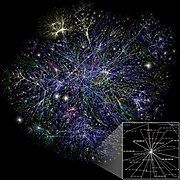Portal:Internet
The Internet PortalThe Internet (or internet) is the global system of interconnected computer networks that uses the Internet protocol suite (TCP/IP) to communicate between networks and devices. It is a network of networks that consists of private, public, academic, business, and government networks of local to global scope, linked by a broad array of electronic, wireless, and optical networking technologies. The Internet carries a vast range of information resources and services, such as the interlinked hypertext documents and applications of the World Wide Web (WWW), electronic mail, telephony, and file sharing. The origins of the Internet date back to research that enabled the time-sharing of computer resources, the development of packet switching in the 1960s and the design of computer networks for data communication. The set of rules (communication protocols) to enable internetworking on the Internet arose from research and development commissioned in the 1970s by the Defense Advanced Research Projects Agency (DARPA) of the United States Department of Defense in collaboration with universities and researchers across the United States and in the United Kingdom and France. The ARPANET initially served as a backbone for the interconnection of regional academic and military networks in the United States to enable resource sharing. The funding of the National Science Foundation Network as a new backbone in the 1980s, as well as private funding for other commercial extensions, encouraged worldwide participation in the development of new networking technologies and the merger of many networks using DARPA's Internet protocol suite. The linking of commercial networks and enterprises by the early 1990s, as well as the advent of the World Wide Web, marked the beginning of the transition to the modern Internet, and generated sustained exponential growth as generations of institutional, personal, and mobile computers were connected to the network. Although the Internet was widely used by academia in the 1980s, the subsequent commercialization in the 1990s and beyond incorporated its services and technologies into virtually every aspect of modern life. (Full article...) Selected article
The history of the Internet dates back to the early development of communication networks. In the 1950s and early 1960s, prior to the widespread inter-networking that led to the Internet, most communication networks were limited by their nature to only allow communications between the stations on the network. Some networks had gateways or bridges between them, but these bridges were often limited or built specifically for a single use. One prevalent computer networking method was based on the central mainframe method, simply allowing its terminals to be connected via long leased lines. This method was used in the 1950s by Project RAND to support researchers such as Herbert A. Simon, in Pittsburgh, Pennsylvania, when collaborating across the continent with researchers in Santa Monica, California, on automated theorem proving and artificial intelligence.
Selected picture Lolcats are images combining photographs of animals, most frequently cats, with a subjectively humorous and idiosyncratic caption in broken English referred to as Kitty Pidgin, Kitteh, or lolspeak. The meme originated in the rule 1 and 2 imageboards as the Caturday internet phenomenon. The name "lolcat" is a compound word of "lol" and "cat". The phenomenon is also referred to as cat macros. Lolcats are created for photo sharing imageboards and other internet forums. News
Wikinews Internet portal
WikiProjects
Did you know (auto-generated) -
Selected biographyLeonard Kleinrock (born June 13, 1934 in New York) is a computer scientist, and a professor of computer science at UCLA, who made several important contributions to the field of computer networking, in particular to the theoretical side of computer networking. He also played an important role in the development of the ARPANET at UCLA. His most well-known and significant work is his early work on queueing theory, which has applications in many fields, among them as a key mathematical background to packet switching, the basic technology behind the Internet. His initial contribution to this field was his doctoral thesis in 1962, published in book form in 1964; he later published several of the standard works on the subject. His theoretical work on hierarchical routing, done in the late 1970s with his then-student Farouk Kamoun, is now critical to the operation of today's world-wide Internet. General images -The following are images from various internet-related articles on Wikipedia.
Selected quoteMore Did you know...
Main topics
Featured contentCategoriesRelated portalsThings you can do
Associated WikimediaThe following Wikimedia Foundation sister projects provide more on this subject:
Wikipedia's portals |





















































